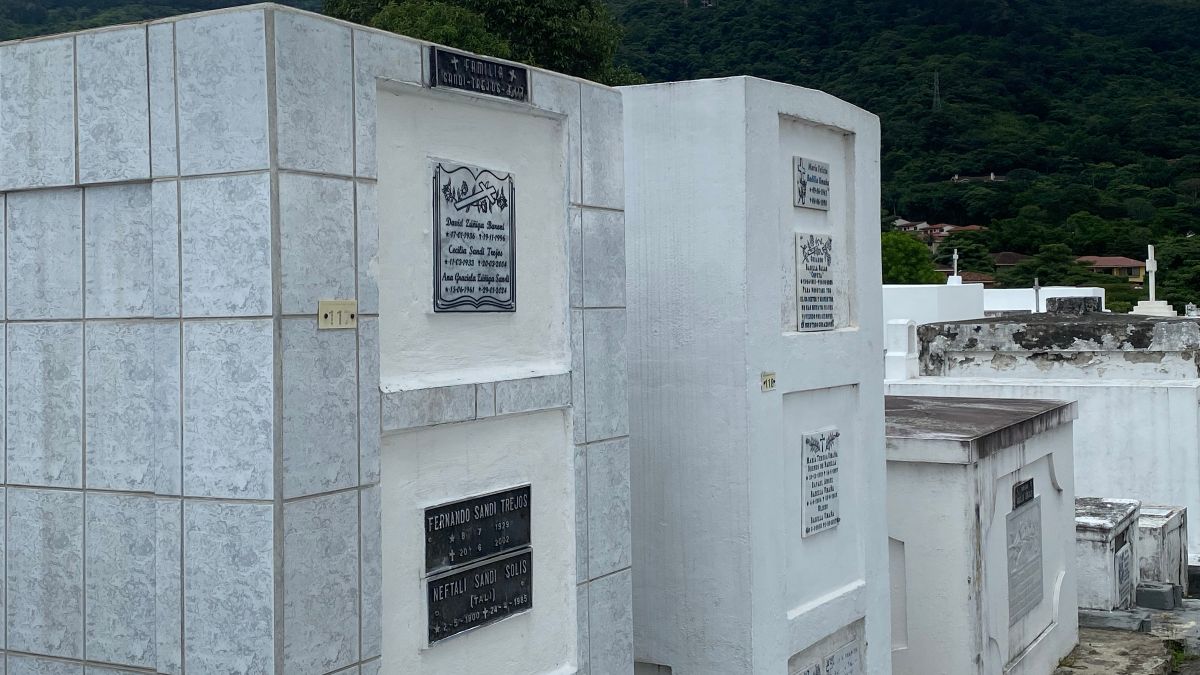Interesting Cemeteries
7 min readDiscover four of the most interesting cemeteries in Central America, from ornate mausoleums and offshore isles to colorful traditions.
The post Exploring Four Fascinating Cemeteries in Central America appeared first on Central America.

In this article, we take a journey through four of the most interesting cemeteries in Central America, highlighting their rich history, cultural traditions, and architectural splendor.
With a name like mine, it might be a surprise that I haven’t written about this before, but, you know, who wants to think about death? That said, the last couple of years have dealt quite a bit of loss and death my way, from family members and loved ones to friends, acquaintances, and beloved pets. It’s been quite a ride, but I guess that’s what getting older is all about, right? It’s not going to get better for any of us. At least, that’s what I was thinking the other day while visiting my local cemetery here in Costa Rica.
Exploring Local Burial Traditions
I’m not sure, but I think I’d gone there out of curiosity, to take a look and read some names. Maybe to clear my head a little, like I said I’m not sure why I went. I guess I felt an urge to go, so I went. What always strikes me about Latin American cemeteries is how different they are from their equivalents back in the UK, where I’m from. Over there, cemeteries tend to center around churches, and the deceased lie six feet under the ground in plots marked by a stone. Here, you’re not so much buried underground as interred in an above-ground whitewashed vault or family mausoleum, often coming with intricate carvings and statues.
When looking for reasons why they bury the dead like this instead of putting them underground, I saw on Reddit that it’s because of the Spanish. Most Spanish conquistadores in Latin America came from the south of Spain, where the ground is rocky and hard to dig holes. For this reason, they put their dead into above-ground vaults and brought the habit over here with them. I’m not sure how true this is, but I guess it makes sense.
The Influence of Geography and History
Geography could play a part, too. For example, cemeteries in New Orleans are also above ground, just like here. That’s because of the high water table in the city that makes burying bodies impractical. Maybe the amount of earthquakes we get here also necessitates above ground burial? I’m just guessing here, I don’t know. Other cemeteries in the United States, especially Catholic cemeteries like the Holy Cross Cemetery, also offer internment in vaults and mausoleums to keep the Latin way of doing things going for those who want it. It’s nice, I think.
Anyway, as I wondered around my local cemetery pondering all this, I also thought about other interesting cemeteries in Central America that travelers coming to the region might find worth visiting. I came up with four distinct places, one here in Costa Rica, another in Guatemala, and the other two in Honduras and Nicaragua. There are obviously far more than four interesting cemeteries in Central America. I know I haven’t even touched the sides here. But the four sites I’m talking about below are places I’ve personally visited in my almost 25 years living here.
In the following sections, we’ll explore these sites and discover what makes them so memorable. Whether you’re a history buff, a cultural enthusiast, or simply curious about different approaches to death and remembrance, these cemeteries offer fascinating insights into Central American life and traditions.
Cabuya, Costa Rica
The Cabuya Cemetery sits on an island just off the coast of the community of Cabuya, near the town of Montezuma at the bottom of the Nicoya Peninsula. It’s a unique place that’s been used as a burial ground since the 1700s. The cemetery is only accessible during low tide when a rocky path about 200 meters long appears, connecting it to the mainland.
Legend has it that local fishermen found a drowned person near the island and buried them there, starting the tradition. These days, it’s still used for burials, with some graves being quite recent.
When you visit, you’ll see a mix of simple wooden crosses and concrete graves. Some have plastic flowers or personal items, which is common in Costa Rica. The island itself is small, only about 3.5 hectares, and is covered with palm trees and giant cabuyas, the plant that gives the area its name.
One interesting grave belongs to a man named Frank Jaeger. His tombstone has a sculpture of a fist on one side and an airplane propeller on the other. There’s also a mysterious grave with two sculpted heads looking in opposite directions.
If you’re planning to visit, make sure to check the tide times carefully. You don’t want to get stuck out there when the tide comes in. It’s a peaceful place with great views of the coastline, but remember it’s a cemetery, so be respectful. The whole visit probably won’t take more than 30 minutes, but it’s definitely a unique experience in Costa Rica.
Chichicastenango, Guatemala
If you’re in Chichicastenango, Guatemala, you should take a break from the famous market and check out the local cemetery. It’s on a hill a bit away from the town center, and it’s one of the most colorful cemeteries you’ll ever see.
What makes this place special is how it mixes Maya traditions with Catholic beliefs. The result is a riot of color that you don’t usually associate with cemeteries. You’ll see rows of painted crosses and tall mausoleums in every color of the rainbow.
The colors aren’t just for show – they have meanings. White tombs represent purity, turquoise is for protection, and yellow stands for the sun’s life force. Some families paint the graves in the favorite color of the person who died. It’s their way of remembering and honoring their loved ones.
Like neighboring Mexico, Guatemala celebrates Day of the Dead every November. This is when this cemetery really comes to life, so to speak. Families come to clean and repaint the graves. They also just come to hang out with their deceased loved ones, bringing offerings like flowers, incense, candles, and sometimes even chickens. It might sound odd, but it’s all about making peace with death and keeping a connection with those who’ve passed on.
This cemetery isn’t just a place of sadness. Sure, there’s sorrow, but there’s also a feeling of celebration. The colors bring a sense of life to the place. It’s a different way of looking at death, and it might make you think about how your own culture deals with it.
Trujillo, Honduras
The Old Cemetery (Cementerio Viejo) in Trujillo, Honduras, has an interesting history. When I tried to visit back in 2001 or 2002, it was all locked up. But things have changed, and now it’s open to the public, apparently.
This cemetery is right in the center of town, just a short walk from the beach. It’s clean, quiet, and well-maintained, like most cemeteries in Central America. What makes it special is its age – some of the graves here are over 300 years old.
The most famous grave belongs to William Walker, an American who tried to take over parts of Central America in the 1850s. He was executed by firing squad in Trujillo in 1860 at the age of 36. His tombstone simply reads “William Walker: Fusilado, September 12, 1860.” The word fusilado means shot. As a Central America history buff, it was this grave that I specifically wanted to see when I went to Trujillo, and I imagine it’s why most people visit this place.
If you want to visit, the cemetery is open Tuesday to Sunday, from 8:00 AM to noon and again from 1:00 PM to 4:00 PM. It’s a great place to learn about the history of Trujillo and the surrounding area.
Granada, Nicaragua
Granada’s cemetery is the oldest in Nicaragua and one of the most ornate. The cemetery is about 20-minute walk from the center of town, or a short taxi or horse-carriage ride away. Some of the horse carriage guys in the park will even ride you around the cemetery if you ask, so that’s another good way to explore it.
As you enter through the grand archway, you’ll first see the chapel, modeled after L’Eglise de la Madeleine in Paris. This neoclassical building, dating back to 1922, still hosts regular mass services. The cemetery’s most elaborate tombs and mausoleums, often decorated with Italian marble statues, are clustered around this chapel. Further in, the graves become smaller and simpler.
The beauty of the cemetery is striking, with intricate marble statues and mausoleums that reflect the wealth and artistry of Granada’s past. Many statues were crafted by Italian sculptors, adding to the cemetery’s aesthetic appeal. In 2012, in recognition of its cultural significance, it was declared a national historic and artistic treasure by the National Assembly.
Among the notable graves are those of nine former Nicaraguan presidents, including the opulent tomb of Fruto Chamorro. The cemetery is also home to unique sculptures, including a scale model of the Notre Dame Cathedral.
Reflecting on Central America’s Cemeteries
That wraps up my mini tour of what I consider to be the most interesting cemeteries in Central America. As I said, I know there are other equally interesting sites elsewhere in the region, in these countries we’ve mentioned here, and also in Belize, El Salvador, and Panama. I just have no experience with them myself. But the four cemeteries discussed here still offer a unique glimpse into the cultural and historical fabric of the communities they exist in. I hope you take the time to check them out if you’re ever nearby.
James Dyde is the editor of centralamerica.com. He lives in Escazu, Costa Rica.



